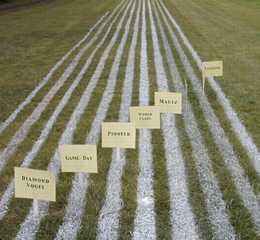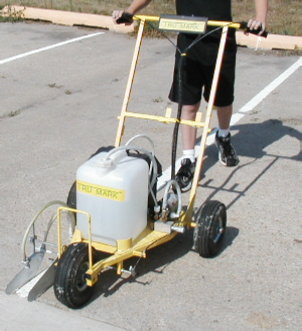Bulk Latex Paint on Sports Fields
 Wikipedia - Acrylic Paint
Wikipedia - Acrylic Paint
Acrylic paint is fast-drying paint containing pigment suspended in an acrylic polymer emulsion. Acrylic paints can be diluted with water, but become water-resistant when dry.
Most bulk latex field marking paints are formulated for dilution with water by the customer.
Acrylics were first made commercially available in the 1950s. Water-based acrylic paints were subsequently sold as "latex" house paints, although acrylic dispersion uses no latex derived from a rubber tree.
Over the years certain materials (or the lack of) have been found which will minimize the impact on natural turf.
Click for Iowa State University bulk latex paint field test plot (2002).
Wikipedia - Paint
Paint consists of four basic elements, pigment, binder, solvent, and additives.
Pigment
- Pigments are granular solids incorporated into the paint to contribute color, toughness or simply to reduce the cost of the paint.
- Pigments can be classified as either natural or synthetic types. Natural pigments include various clays, calcium carbonate, mica, silicas, and talcs. Synthetics would include engineered molecules, calcined clays, blanc fix, precipitated calcium carbonate, and synthetic silicas.
- Hiding pigments, in making paint opaque, also protect the substrate from the harmful effects of ultraviolet light. Hiding pigments include titanium dioxide, phthalo blue, red iron oxide, and many others.
- Fillers are a special type of pigment that serve to thicken the film, support its structure and simply increase the volume of the paint.
- A commercially important pigment is titanium dioxide. Opacity is also improved by optimal sizing of the titanium dioxide particles.
Binder
- The binder, or resin, is the actual film forming component of paint. Binders include synthetic or natural resins such as acrylics, polyurethanes, polyesters, melamine resins, epoxy, or oils.
- Latex paint is a water-based dispersion of sub-micron polymer particles. The term "latex" in the context of paint simply means an aqueous dispersion; latex rubber (the sap of the rubber tree that has historically been called latex) is not an ingredient.
- Latex paints cure by a process called coalescence where first the water, and then the trace, or coalescing, solvent, evaporate and draw together and soften the latex binder particles and fuse them together into irreversibly bound networked structures, so that the paint will not redissolve in the solvent/water that originally carried it.
Volatile Vehicle or Solvent
- The main purpose of the vehicle is to adjust the viscosity of the paint. It is volatile and does not become part of the paint film. It can also control flow and application properties, and affect the stability of the paint while in liquid state. Its main function is as the carrier for the non volatile components.
- Water is the main vehicle for water-based paints.
Additives
Besides the three main categories of ingredients, paint can have a wide variety of miscellaneous additives, which are usually added in very small amounts and yet give a very significant effect on the product. Some examples include additives to modify surface tension, improve flow properties, improve the finished appearance, increase wet edge, improve pigment stability, impart antifreeze properties, control foaming, control skinning, etc.
|
Click here to learn How to Select a Field Marker . The article lists a series of questions and notes concerning the capabilities and features you should consider when making a purchasing decision.
|
|
Click here to understand the cost savings advantage of using acrylic latex paint over aerosol paint.
|
|
Make your lines and stencils stand out with
Tru Mark Premium Quality Field Marking Paints .
Tru Mark field striping paint for synthetic/artificial and natural turf surfaces.
|
 Tru Mark Athletic Field Marker Model E-100 walk-behind athletic field marker has demonstrated the capability to apply acrylic latex traffic zone marking paints. This demonstrated capability adds a new opportunity for customers to use the E-100 as a 3-in-1 sprayer: field marking, traffic zone marking, and herbicide application. The 12-volt 3.3 gallons per minute electric pump supplies sufficient pressure and volume to one of the spray nozzles for a professional looking 4" line. The traffic zone marking paint was diluted with either 16 ounces of water or 16 ounces of latex paint conditioner to 1 gallon of paint.
Tru Mark Athletic Field Marker Model E-100 walk-behind athletic field marker has demonstrated the capability to apply acrylic latex traffic zone marking paints. This demonstrated capability adds a new opportunity for customers to use the E-100 as a 3-in-1 sprayer: field marking, traffic zone marking, and herbicide application. The 12-volt 3.3 gallons per minute electric pump supplies sufficient pressure and volume to one of the spray nozzles for a professional looking 4" line. The traffic zone marking paint was diluted with either 16 ounces of water or 16 ounces of latex paint conditioner to 1 gallon of paint.